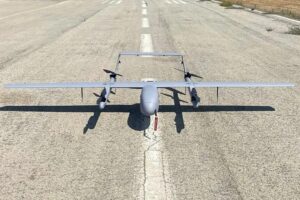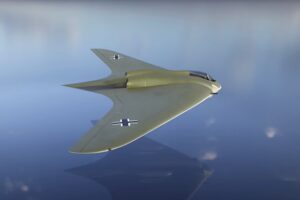The following guest post about drone use throughout the conflict in Ukraine was written by Mary-Lou Smulders, Chief Marketing Officer at Dedrone. Dedrone, which was acquired by Axon in 2024 is an airspace security company that builds technology to detect, track, identify, analyze and mitigate drone threats while enabling “good” drones to fly.
As the conflict in Ukraine continues, the lessons learned about uncrewed aerial vehicles (UAVs) and airspace control will influence military strategies worldwide for years to come. The historical context of air superiority, rooted in the experiences of World War I, serves as a backdrop for this ongoing evolution in aerial warfare.
During WWI, airspace superiority was defined as the side that had the most capable airplanes (crewed aircraft) flown by the best pilots. This control was crucial for effective reconnaissance, bombing missions and ground support.
For nearly a century, the principles of air superiority remained largely unchanged, influencing military strategies in conflicts ranging consequently from World War II to the Cold War. However, the current conflict in Ukraine has highlighted a significant shift in how air superiority is achieved.
While traditional air forces relied on crewed aircraft, the introduction of UAVs has transformed battlefield dynamics. Ukraine’s innovative use of drones, such as the Turkish made Bayraktar TB2 and various first-person view (FPV) models, has effectively allowed it to counter a numerically superior Russian air force. This reliance on UAVs has enabled Ukraine to conduct reconnaissance, target enemy positions and boost morale by disseminating successful strike footage, demonstrating that control of the skies can now be contested through advanced technology and resourcefulness.
By the end of 2022, Ukraine had successfully repelled much of the Russian invasion force, a remarkable achievement attributed to its resourcefulness in leveraging UAV technology to overcome shortages in conventional munitions.
This transformation in aerial warfare has fundamentally and forever changed the definition of air superiority, setting a precedent for future conflicts — and emphasizing the importance of adaptability and innovation in modern military strategy.
The role of airspace security in Ukraine’s Defense
At the start of the invasion, Ukraine possessed a small air force consisting of Soviet-vintage combat aircraft, of which only one-third were airworthy. It was hopelessly outmatched by the Russian Air Force, which fielded more modern systems and in vastly greater numbers. And yet, Russia failed to penetrate deep into Ukraine’s airspace, thanks to a robust air defense system based on the S-300. For similar reasons, Ukraine’s small fleet of Sukhoi SU-27s and MIG-29s didn’t dare launch raids into Russian-controlled territory.
This impasse led both sides to rely on drones for missions that would traditionally have been conducted with attack aircraft. Ukraine turned to the Bayraktar TB2 — an affordable turboprop UAV that had already seen battle in Iraq, Syria and Libya. During the initial counter-offensive, where it pushed Russia’s forces from the outskirts of Kyiv (and then from the entire North of the country), the Bayraktar TB2 engaged a variety of Russian targets, including armoured vehicles, surface-to-air missile installations and even two fuel trains.
They not only proved that the Bayraktar TB2 could fly where crewed aircraft couldn’t. But, more importantly, it relayed footage of its attacks back to the operator, which could then be disseminated online. In many respects, the Bayraktar TB2 wasn’t just a capable weapon platform it becames a valuable tool in the information war as well, helping raise Ukrainian morale as it faced impossible odds. The exploits of this UAV even inspired a song, which later achieved viral international notoriety.
As the war dragged into its second year, Ukraine’s pushback of Russian forces came to a stop, with the frontlines largely stabilized. This presented a challenge. Russian military doctrine emphasizes superior artillery firepower, as the Royal Services Institute noted. Ukraine was, once again, outgunned, with the country experiencing acute shortages of both Soviet-era shells, as well as those for Western-provided howitzers.
And so it again turned to UAVs to overcome its disadvantages. Ukraine sidelined the Bayraktar TB2 — which was increasingly vulnerable to Russian air defenses and electronic warfare — and instead pivoted to smaller, cheaper first-person view (FPV) drones. These included Western-made UAVs — like the American Switchblade 300 — and repurposed consumer drones, but most consisted of domestically-made aircraft built from ad-hoc workshops nationwide.
Building resilience and countering threats
In 2024, the Ukrainian government committed $2 billion to the production of FPV drones, and according to Ukrainska Pravda, there are 200 suppliers across the country. Using easily accessible components and repurposed munitions, often taken from landmines and rocket-propelled grenades, these FPV drones have been used to devastating effect. As with the Bayraktar, Ukraine’s military routinely shares footage of successful FPV strikes, providing welcome morale boosts as the war dragged into its third year. Crucially, they have reduced Ukraine’s dependence on international military aid.
Russia also turned to drones, deploying the Iranian-designed HESA Shahed-136 to target Ukraine’s critical infrastructure, particularly its power generation and transmission facilities. Although considerably more expensive than Ukraine’s FPV drones, they can operate over long distances while still being cheap enough to deploy in large numbers.
Ukraine has responded to this threat with similar resourcefulness. Rather than use its limited air defense missile inventory, it has developed a sophisticated electronic warfare apparatus, which can disrupt the communication and navigation systems of the Shahed-136, even when deployed in large swarms.
This sophisticated counter-drone technology has demonstrated its value in evening once impossible odds, as demonstrated on Sunday, Jan. 5, when — under the cloak of an electronic warfare system — Ukraine launched another incursion into Russia’s Kursk region. Unable to use its own FPV drones, Russia was caught off-guard, and it was forced to rely on traditional aviation and artillery assets to respond.
Ukraine has also chosen to protect its most critical infrastructure with kinetic defense systems, like the German-made Gepard. Although most Western militaries have retired the Gepard in favor of high-tech alternatives, based on the assumption that future air threats would come from high-altitude crewed aircraft, the Gepard’s radar-guided cannons have proven capable at engaging kamikaze drones at close range.
The Russian-Ukraine War is often described as the “first full-scale drone war.” For outsiders, it provides grizzly lessons about how UAVs can help a defender overcome insurmountable odds and how to adapt when conventional military aircraft aren’t available. Ukraine’s use of drones in an offensive capability and its experience in defending against Russian drone swarms has already changed the aerial warfare rulebook.
Just like WW1 — and the impact of early biplanes and tanks — changed the military rulebook, the same is happening in Ukraine. Kyiv’s resourcefulness in using UAVs offensively — and defending against hostile drones — will directly inform the drone/counter-drone defense strategy and procurement for years to come. But as the war drags into its third bloody year, we should never forget the human cost of these lessons.
-By Mary-Lou Smulders, Chief Marketing Officer at Dedrone
If you’d like to submit a guest post, contact The Drone Girl here.
The post The first ‘drone war:’ how the Ukraine conflict is redefining military airspace strategy appeared first on The Drone Girl.


 Majestic Aerial Views of the Palace of the Island, Lake Annecy, France!
Majestic Aerial Views of the Palace of the Island, Lake Annecy, France!  Drone Footage on HOsiHO.com
Drone Footage on HOsiHO.com 





